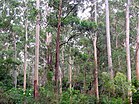The ecology of Sydney, located in the state of New South Wales, Australia, is diverse for its size,[1] where it would mainly feature biomes such as grassy woodlands or savannas and some sclerophyll forests, with some pockets of mallee shrublands, riparian forests, heathlands, and wetlands, in addition to small temperate and subtropical rainforest fragments.[2][3]
There are 79 vegetation communities in the Sydney metropolitan area that are identified, described and mapped.[4] The combination of climate, topography, moisture, and soil influence the dispersion of these ecological communities across a height gradient from 0 to 200 metres (0 to 700 ft).[5] There are many hiking trails, paved and unpaved roads for exploring the many different biomes and ecosystems.[6][7][8]
Savannas (or grassy woodlands), the most predominant biome in the Sydney region,[9] mainly occur in the Cumberland Plain west of Sydney CBD, which generally feature eucalyptus trees that are usually in open, dry sclerophyll woodland areas with shrubs (typically wattles, callistemons, grevilleas and banksias) and sparse grass in the understory, reminiscent of Mediterranean forests.[10] The plants in this community tend to have rough and spiky leaves, as they are grown in areas with low soil fertility.
Wet sclerophyll forests, which are part of Eastern Australian temperate forests, have narrow, relatively tall, dense trees with a lush, moist understory of fleecy shrubs and tree ferns. They are mainly found in the wetter areas, such as Forest District and the North Shore.[11]
It has been calculated that around 98,000 hectares of native vegetation remains in the Sydney metropolitan area, shaping the geography of Sydney, about half of what is likely to have been existing at the time of European arrival.[12]
- ^ Benson, D.H. and Howell, J. (2000) Sydney’s Bushland — More than Meets the Eye, Royal Botanic Gardens, Sydney.
- ^ "The Native Vegetation of the Sydney Metropolitan Area Volume 2: Vegetation Community Profiles" (PDF). NSW Government Catchment Management Authority and Office of Environment & Heritage. Retrieved 30 January 2019.
- ^ Fairley, A.; Waterhouse, D. (2005). West Sydney Wild – Exploring Nature in Sydney's Western Suburbs. Dural, NSW: Rosenberg Publishing Pty Ltd.
- ^ The native vegetation of the Sydney metropolitan area by NSW Environment & Heritage. Retrieved 28 January 2023.
- ^ French K, Pellow B and Henderson M 2000, Vegetation of the Holsworthy Military area. Cunninghamia 6(4): 893-939.
- ^ SYDNEY WALKS by Sydney.com
- ^ The best bushwalks in and around Sydney by The Daily Telegraph
- ^ Sydney’s top 5 walks by NSW National Parks and Wildlife Service
- ^ "Coastal Valley Grassy Woodlands". NSW Environment & Heritage. Retrieved 15 December 2019.
- ^ "Dry sclerophyll forests (shrub/grass sub-formation)". NSW Environment & Heritage. Retrieved 15 October 2016.
- ^ "Wet sclerophyll forests (grassy sub-formation)". NSW Environment & Heritage. Retrieved 16 March 2017.
- ^ James, T. McDougall, L. and Benson, D.H. (1999) Rare Bushland Plants of Western Sydney, second edition, Royal Botanic Gardens, Sydney.




